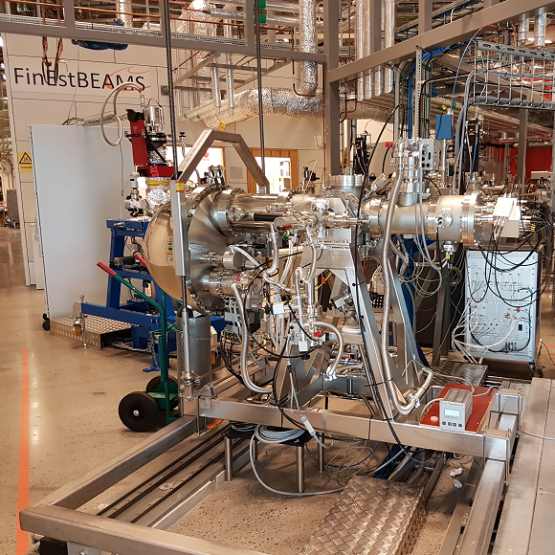The Gas-phase end station (GPES), shown in the photo below, has been designed for photoelectron-photoion coincidence (PEPICO) experiments of gas phase targets and samples with high vapour pressure [1]. The main instruments are a Scienta R4000 electron spectrometer and a momentum imaging multi-hit-capable ion Time-of-Flight (TOF) spectrometer. They are equipped with fast position-sensitive detectors that are specifically designed for coincidence measurements. The electron and ion spectrometers can also be used independently for high-resolution electron and ion spectroscopy or to collect electron and ion yields as a function of photon energy. The coincidence set-up is controlled by custom-made software.
The GPES has been designed to accommodate a variety of sample preparation systems, provided by the FinEstBeAMS consortium, the LDM team at MAX IV or external users. Available sample delivery systems include a gas inlet with a narrow needle, an aerosol sample delivery system, and a liquid microjet source.
A second, exchangeable chamber can be mounted downstream of the electron-ion coincidence set-up. An empty vacuum chamber with a support is available to users whose instruments do not fit or cannot be used in the GPES. It is a replica of the GPES vacuum chamber [1] but without mu-metal shielding. This second chamber can be moved to the focal plane of the beamline for the best experimental conditions, when a connection pipe between the GPES and the beamline is removed.
A setup has been developed for negative-ion/positive-ion coincidence (NIPICO) experiments. It is composed of two TOF spectrometers mounted opposite one another. The TOF spectrometer for positive ions is loaned from the GPES, while the other TOF spectrometer, which is used to detect negative ions, is specifically dedicated to this setup. In NIPICO experiments, the flow of electrons to the detector of negative particles is reduced with an external magnetic field. By removing the magnets, this setup can also be used to measure such PEPICO spectra where it is not necessary to know the kinetic energies of emitted electrons.
A whole week of single-bunch (SB) operation will be available in each semester. If you want to apply for a beamtime in a SB week, you should indicate that clearly in your beamtime proposal. In that case, the scientific motivation of your proposal should be based on the use of SB operation. In SB operation, the time interval between light pulses is 320 ns, instead of the usual 10 ns in the multi-bunch operation.
It might also be possible to arrange some SB shifts outside of the SB week if other beamlines at the 1.5 GeV ring agree with it. If you are interested in such a possibility, please check the corresponding box under the selection of the Gas-phase end station during the proposal submission in DUO and motivate your need of SB operation in the proposal.
A magnetic bottle electron spectrometer with a 2-m drift tube is available to regular users for proposals intending to use the single-bunch week. However, at the present stage, such proposals should be prepared by consulting the researchers from the University of Oulu or the University of Kassel, and an eventual beamtime should be carried out in collaboration with them.
Please note that FinEstBeAMS does not have a chopper in the beamline.
Gas-phase research activities at FinEstBeAMS are part of Low-density-matter (LDM) research at MAX IV. Gas-phase users of FinEstBeAMS have a possibility to benefit from sample delivery systems and scientific equipment that are available in the LDM team and at other LDM related beamlines. In particular, a recently developed aerodynamic lens sample delivery system is available for general users at FinEstBeAMS. Please see Low Density Matter at MAX IV for further information.
[1] K. Kooser et al., J. Synchrotron Rad. 27, 1080 (2020).
